
Edyn Teitge
The Tour Divide, Day by Day
- ,
- , Adventures
In June 2024, Edyn Teitge became, at 15, the youngest solo rider of the Tour Divide. This is his story via his own words, day by day through the ride. Images throughout by Edyn and Eddie Clark Media.
The Tour Divide is one of the world’s longest and most well-known off-road bikepacking races. Stretching nearly 2,700 miles from Banff, Alberta, Canada to the US-Mexico border at Antelope Wells, New Mexico, it closely follows the Great Divide Mountain Bike route along the spine of the continent. The route gains around 150,000 feet of elevation with conditions ranging from unkept narrow single-track sections of the CDT, to smooth gravel and dirt roads, to death mud, and to long stretches of pavement. And somehow I got it in my mind that it would be a “fun” thing to do.
I knew I wanted to do the Divide from the moment I heard about it, I didn’t know when but I knew I was going to take it on eventually. The first bikepacking race I did solo was the Idaho Smoke ‘n’ Fire 400, a 400-mile race in the backcountry of Idaho, and this first race truly opened my eyes to the whole world of bikepack racing. That following winter I did the Fat Pursuit and this continued to open my eyes to winter ultras and the possibility of where it is possible to travel on a bike. The first time I ever really thought of a bikepacking race as a race was at the Stagecoach 400 in southern California. For this race I had such a minimal kit that it fit in the frame bag of a mountain bike, I didn’t plan on sleeping and my main goal was speed. But none of these races truly compare to the Divide.

The race started in waves of around 20 on Friday, June 14th. The first day was one of my favorites as we rolled beneath the truly stunning peaks of the Canadian Rockies. The weather on day one couldn’t have been much better either. The sun was out with just a few clouds in the sky keeping it right about the perfect temperature. On the descent of one of the first passes I was riding in a small group of people and we were stopped by a small grizzly just chilling by the trail. It didn’t seem to care very much about us and we were able to just ride on by. One of the most memorable things from day one, and I can’t say it is a very fond memory, was Koko Claims. This steep road is impossible to ride because of the big rocks that even make it difficult to walk up. And when we reached the top the downhill wasn’t much better, there were a ton of stream crossings and big snow patches which forced us to walk almost as much as we did on the uphill. On day one I rolled into Fernie around midnight and was able to get a room at a hostel after a little resupply and dinner at the 24-hour 7 11.

Day two is when the nice weather came to an end. The day started overcast but still pretty nice. The sun even came out for a bit, but just around noon, it started raining. Up at the summit of the second pass of the day is where I met the first bit of snow. It was coming down in big flakes but luckily it wasn’t quite cold enough for the snow to start sticking to the ground. On the descent from the summit, I hit a rock hard and I immediately heard air rushing out of my tire. I had slashed a hole in my sidewall. With the brief break in the storm, I threw a tube in as fast as I could, and within a few minutes, I was riding again. I had heard rumors of “The Wall” but wasn’t quite sure what it was, it turns out the name is pretty accurate. It is a very narrow trail that is only a few miles long but it certainly is not an easy few miles. The crux or the actual wall is less than half a mile long but it is very steep with lots of downed trees crossing the trail and to add on top of it all the constant rain all day made it a mudhole. After pushing my bike out of that mess, it was onto the last and tallest summit of the day. Towards the top there was about an inch of snow and a very cold wind so I made it up and over as fast as I could. The steep downhill on the other side was fast and fun and brought me almost all the way to the US border. Crossing the border was much simpler and faster than I had anticipated. I thought I might be questioned as to what a fifteen-year-old was doing alone with his bike trying to cross the border but nope, they just let me right on through. I decided to spend the night at a hotel in Eureka to try and get a chance to warm up and dry all my gear and I was lucky enough to have gotten the last room available.

The Weather on Day three was a little better but still not great, it was overcast in the morning and it rained and snowed on and off for the rest of the day. On one of the last descents going into Whitefish, my flat repair failed me. So I once again had to throw in another tube and just cross my fingers that this one didn’t pop, luckily it didn’t. About ten miles out from Whitefish I got phone service so I called a burger place and made an order for four burgers, they were done right as I rolled into town so I didn’t have to wait for things to be made, and this continued to be part of my strategy throughout the race. Since the route doesn’t go through downtown Whitefish and I didn’t want to go off-course I decided to continue to Columbia Falls where there was a bike shop I could repair my tire in. Unfortunately, the shop didn’t have the tire width I wanted so I tried to sew up the sidewall but the tear was too close to the bead so the tire wouldn’t seat on the rim. I decided to get a new tire even though it was skinnier than would be ideal but it was better than one with a sidewall tear. After wasting time trying to sew the tire I was in the bike shop for about two hours and eager to get riding. That night I slept in the warmth of a pit toilet just out of Ferndale.
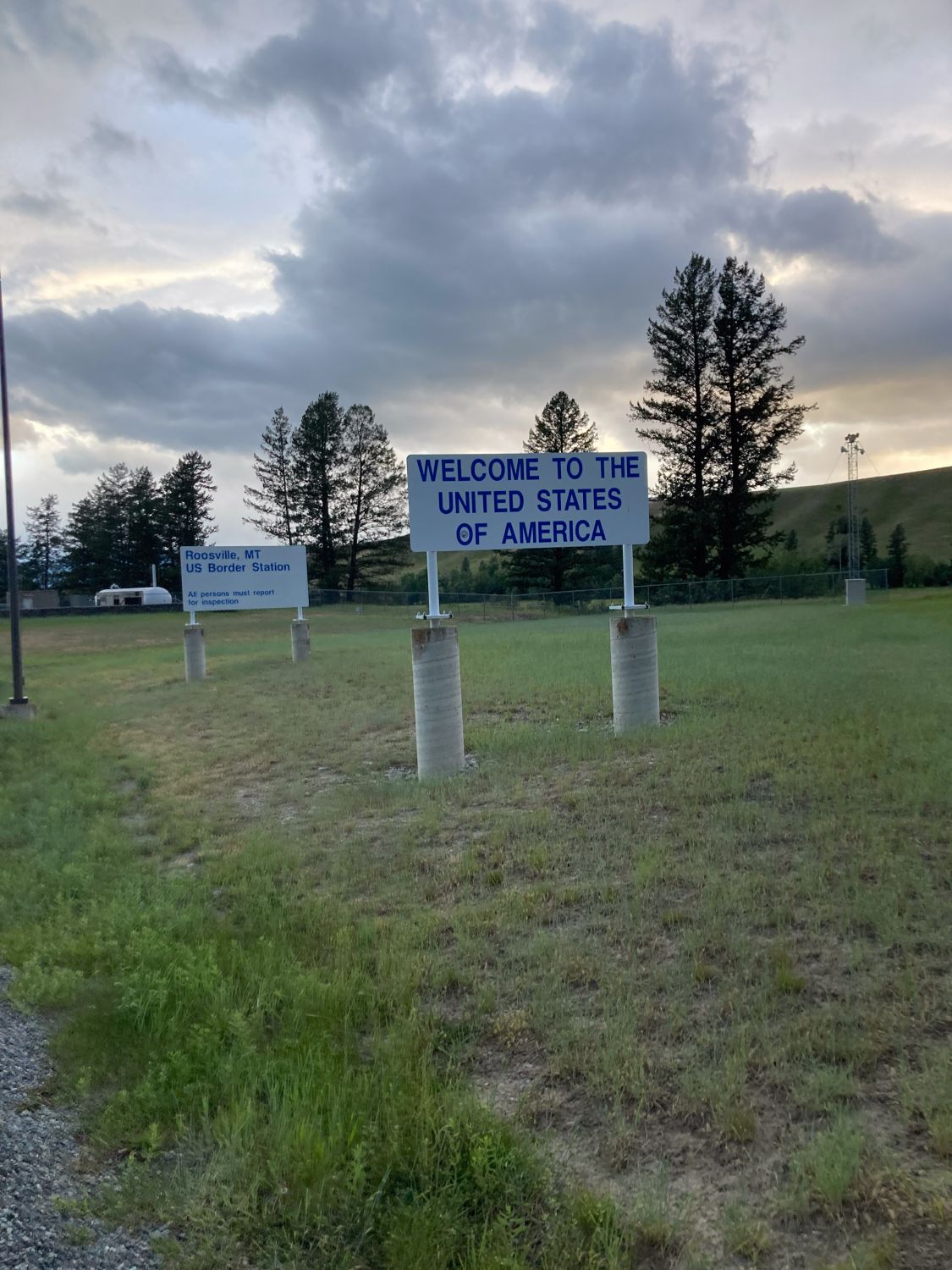
The next day was one of the hardest out of the whole ride. It started overcast like the others but pretty soon it was raining. On the uphills it was warm but on the downs, it was pretty miserable. My fingers got really cold and with a big pass coming up I decided to stop in the cover of a pit toilet with a few other riders. I bundled up with almost all of the gear I had and tried to heat my freezing fingers. Once I got climbing it was better, the rain even let up for a bit but that wasn’t very long-lived. Up on the summit, it was a winter wonderland with wet snow clinging to the trees and about an inch of snow on the ground. The descent wasn’t as bad as I had thought it would be, the rain sort of let up and I saw the first bit of blue sky I had seen in a while, just a small patch but it felt good. I had heard that the basement of the church in Ovando was open to the riders and it sounded like a pretty nice place to stay. It definitely was with a heater to dry stuff by, a kitchen, and even a shower and laundry machine. One other rider slept there that night and after eating and taking a shower it was time to go to bed. Unfortunately, my charging block had fallen out of my bag so I couldn’t top my devices up but at least I still had some charge left in my power banks to charge what needed it.
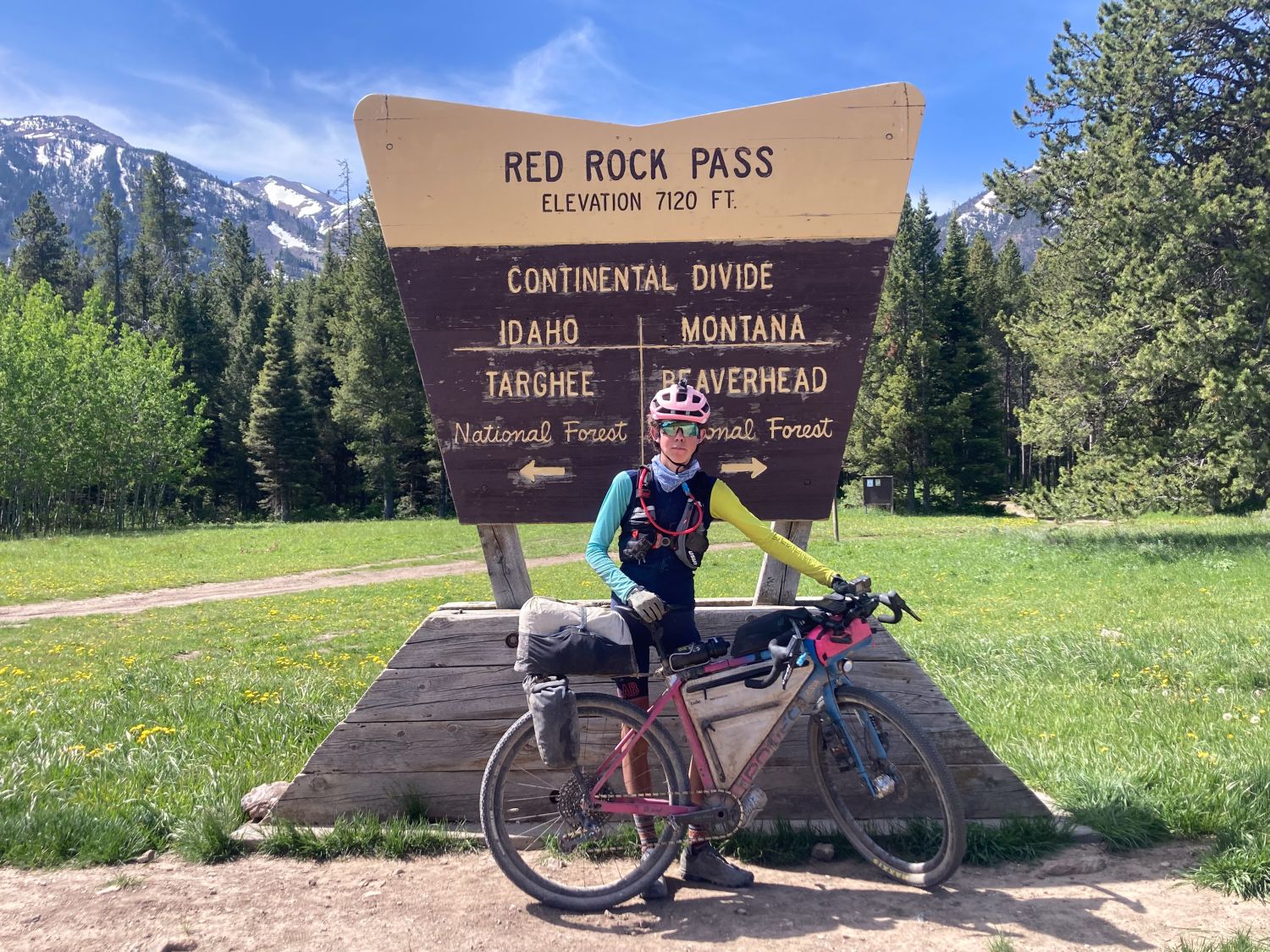
I took the next morning a little slower and had a giant sit-down breakfast in the cafe in Ovando. One of the main reasons I took it slower was waiting for the store to open so I could buy myself a charging block but a huge breakfast was certainly a bonus. Of course, the day started off raining and at the summit of the first pass of the day there were once again large snowflakes falling, however, this weather didn’t last very long. Once I made it to Lincoln, the weather changed for the better this time. The sun finally came out and as I sat there eating my frozen burrito I was finally able to get warm and take off my rain jacket and pants. The sun decided to stay out for the rest of the day and it was the first time since day one I was able to ride in shorts and my jersey. A few hours before getting to Helena I called a bike shop and asked if they could set a new tire and a few other things outside because I knew I would probably get there after hours. Thankfully they were very helpful and when I rolled into town I put on a new, much wider, front tire and replaced my smoked brake pads. By the time I finished my bike maintenance, it was getting late, and with a very cold night forecasted I decided to get a hotel, warm up, and get an early start to the morning.

As I rolled out of Helena I could see frost on the grass and my Garmin said it was below freezing but at least it wasn’t raining and when the sun rose it quickly heated things. I rolled into Butte mid-afternoon and decided I was going to send it to Wise River. There were clouds in the sky and you could see where it was raining off in the distance but most of the storms were small and isolated and I got pretty lucky other than a light ten-minute rain. I rode up the long climb to Fleecer Ridge with two other people and we got to the top just in time for a stunning sunset and moonrise. It was a steep chunky descent off the ridge and at the bottom of the worst part my brake rotors were hot enough to turn water to steam. After more fast descending, I made it to Wise River and got a hotel and once I took a hot shower, I was asleep in an instant.
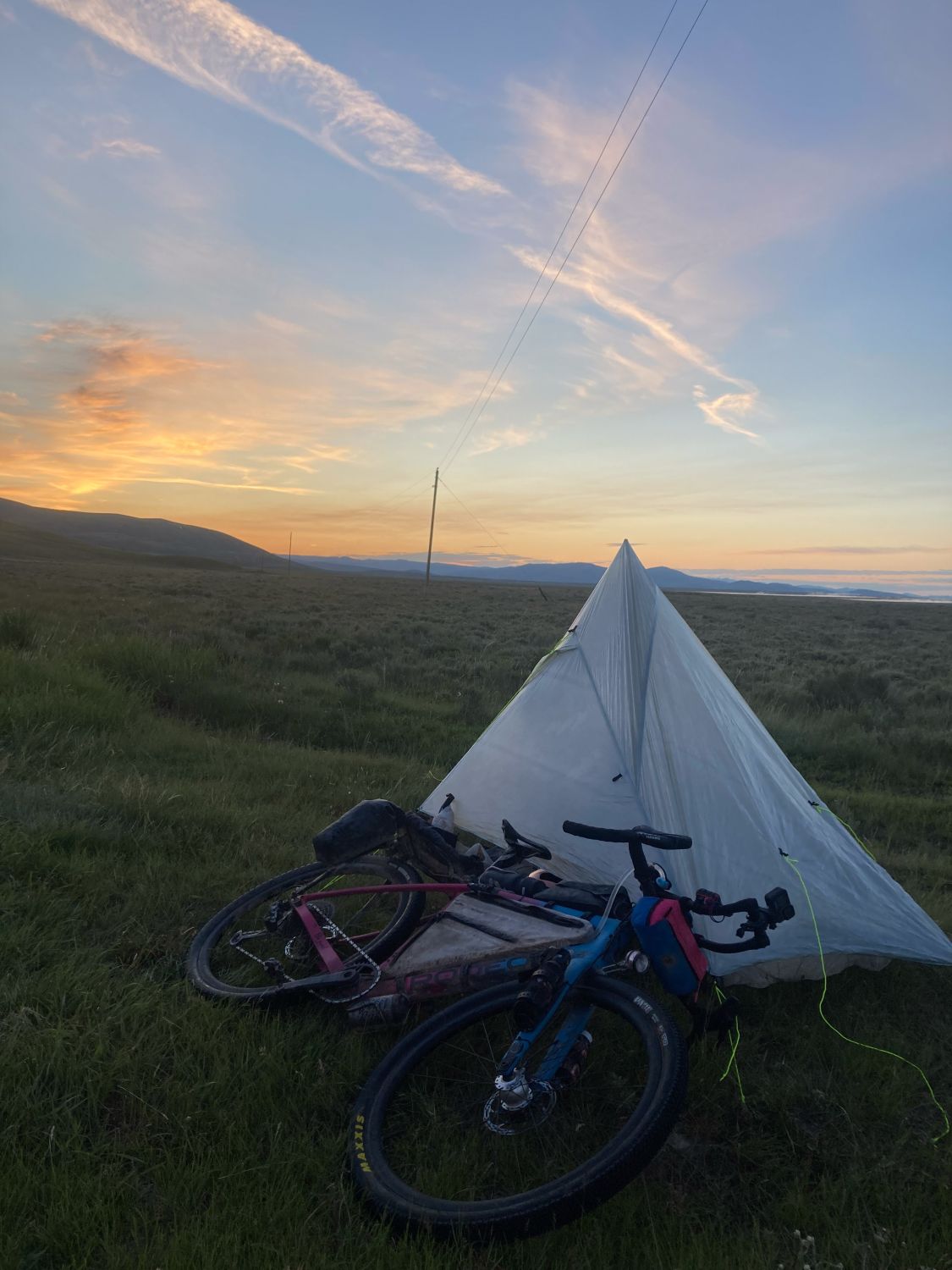
The morning started cold again but once I was riding I was warm. The climb out of Wize River is a long pavement one with a long pavement descent which was a nice break from the harsh roads before and luckily there were not many cars. Once the sun got up in the sky it was the hottest day so far and the scenery had completely changed from dense pine forests to hot and dry sagebrush plains. The pass before Lima was one of the most brutal, it wasn’t super steep or technical but it had been re-graded with chunky gravel that made the riding agonizingly slow and the fact it was almost 100 degrees certainly didn’t help. I made a quick resupply in Lima and camped about ten miles down the road. It was my first time on the trip setting up my tent and despite condensation in the morning, it was a pretty good sleep.

After eating some breakfast and packing up my tent I was riding once again. Around 11 is when I finally crossed the border into Idaho which was a pretty good feeling. Not only was I in familiar territory in my home state, but finally getting out of Montana marked the end of one of the hardest sections. This excited feeling quickly dissipated as I was met with a sandy, washboarded trail after leaving Island Park, but luckily it didn’t last very long and soon enough I was back onto the prime Idaho gravel, which also didn’t last very long as we crossed over into Wyoming on the same day. As night rolled in I could hear wolves howling off in the distance which pushed me to continue and find an established campground. Unfortunately, the campground I rolled into was booked out but fortunately, after asking a group of people if I could set up a tent in the corner of their campsite I had a place to sleep.

When I got up in the morning I was greeted with a stunning view of Jackson Lake and the Teton range towering behind. The day started pretty easy with a smooth road along the lake but soon enough we were climbing again. Aside from the first day, this was one of the prettiest days so far but that certainly didn’t mean it was easy, with two huge passes towering over 9,000 feet. The first went by pretty fast and the gas station at the top was definitely nice but the second pass was certainly harder. It was the infamous Union Pass, the uphill wasn’t too bad, it had some steep parts but the downhill was the most brutal part, it was like riding in a riverbed and the constant bumping over rocks was more tiring than the uphill. Luckily this didn’t last too long and soon enough it was smooth pavement to Pinedale. I was racing against the clock to try to get to Pinedale before the Subway closed and the tailwind helped by getting me there just in time to order four huge sandwiches.
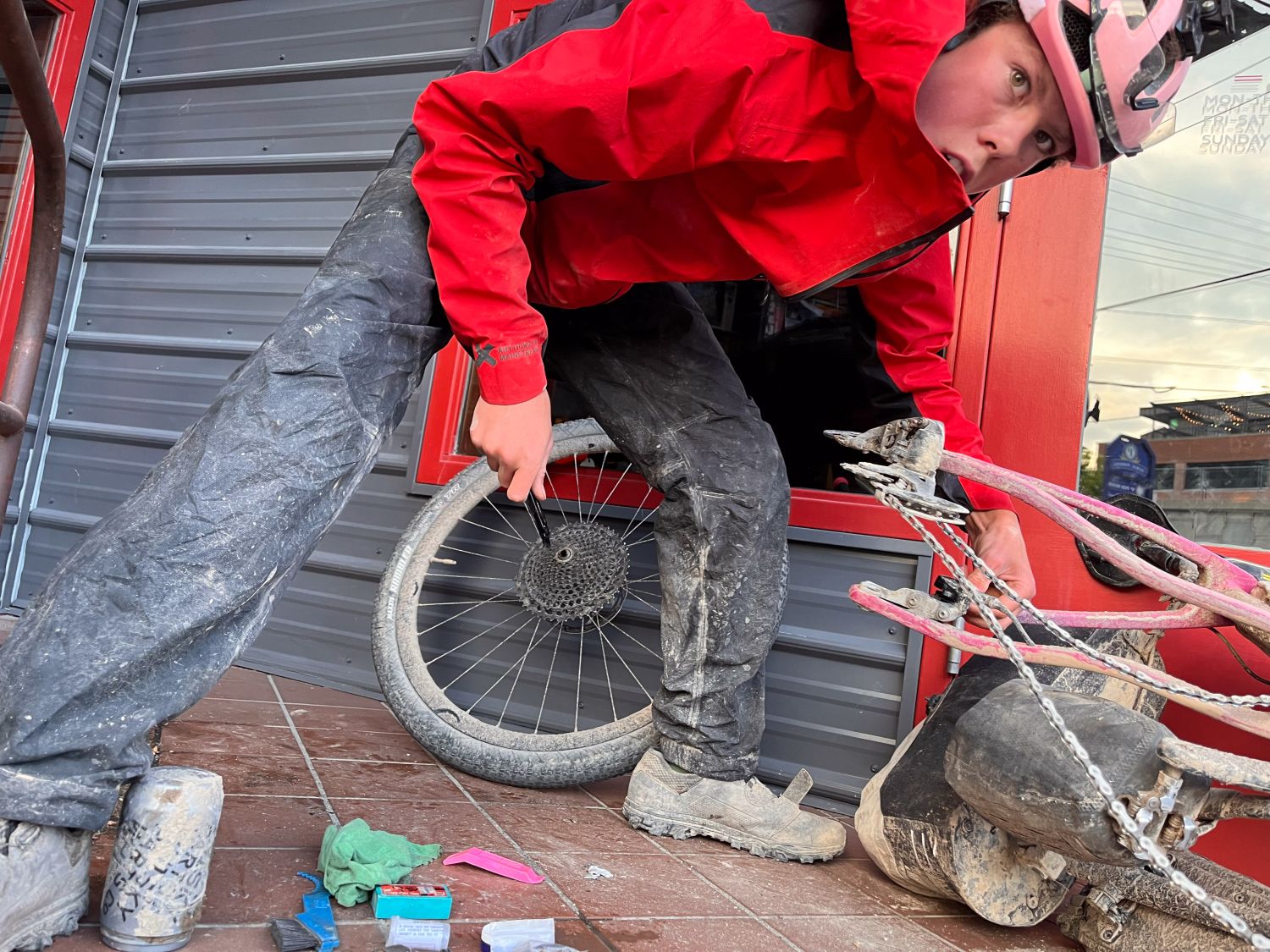
That night I slept in a bed and breakfast which was nice but it certainly didn’t make it easy to wake up. Even though I was on my bike early it was already getting hot as I got my first taste of the Great Basin. It was also getting windy and the steep hills made my progress demoralizingly slow. I made it to Atlantic City late afternoon and probably spent way longer sitting in the shade than I should have but the little rest from the hot sun was nice. After maxing out my water capacity for the long, desolate stretch of the true Great Basin the bike felt sluggish with the extra 15lbs of weight. Luckily the wind was working in my favor for the first portion of the basin out of Atlantic City which allowed me to make a really good time. This was of course until the wind wasn’t helping and I was once again battling it. I made it to Wamsutter around one am, exhausted and ready to rest. I set up my tent in an overgrown field and was quickly asleep.

I got up late and by the time I had eaten and put my gear away, the sun was already high in the sky and hot. It was slow going on loose gravel roads with tankers flying by at top speed. There was occasionally some cloud cover which was nice but it also made me nervous as I could see dozens of little squalls around me and I knew if the dirt I was riding on got wet it could turn into miserable death mud. Less than five miles from the little town of Savory and the Colorado border which marked the end of the Basin I was hit by one of these squalls. Even though it only lasted ten minutes I was instantly soaked and in just a few minutes of the heavy rain, the ground was turned into a slippery mess. Because I was on a slight downhill I was able to keep my wheels moving and fortunately, the road changed to gravel which was less affected by the rain. Once I hit pavement I took a quick break to scrape the mud off my bike and components before it dried like cement. The change in scenery once I made it to Colorado was a morale booster, finally, there were trees and mountains, not just the grey sagebrush and grass in the basin. My plan at first was to take a quick break at Brush Mountain Lodge and try to continue to Steamboat but I was quickly sucked into the opportunity to do laundry and have a hot meal and decided to spend the night there. It was hard to stop with such a short day but I felt like I needed it and I did.

After a reset I was ready to go at five the next morning, the day started with a long climb that was followed by a harsh rocky descent, however, it quickly turned into one of the smooth roads that Colorado is known for. I knew I wanted to spend as little time as possible in Steamboat because it was a place that notoriously drew riders in so to keep my visit short I did most of my resupply at the Clark store which was about ten miles before Steamboat. After riding through the tempting town it was back to the open roads. I could see storm clouds gathering and the occasional roar of thunder so I knew I wanted to make it as far as possible before the storm hit. Somehow I threaded the needle only getting a little sprinkle of rain but I would certainly not be so lucky in the days to come. After Steamboat, there was the first taste of the Colorado boonies. I knew I was close to things but winding through the mountains on a narrow double track felt so remote. That night I camped on the reservoir outside of Kremmling and unfortunately that’s where my water filter bag decided to fail on me so I knew in the morning I would have to get to Silverthorne where there was an REI where I could get a new filter.

Just as I was hopping on my bike to get the day started another rider came by and I was able to borrow their filter so I could have at least some water for the 50-mile stretch to Silverthorne. After getting what I needed from Silverthorne I was back on the bike and greeted by a long, paved bike path that went all the way to Breckenridge. Because I had gotten everything I needed in Silverthorne I was able to cruise right on through one of the many enticing Colorado towns. The climb out of Breckenridge was a long one but it was a smooth road with a consistent grade and I was feeling good so it went by fast. At the summit of Boreas Pass I couldn’t tell what the weather was doing so just to be safe I put on my rain pants and jacket. It only sprinkled a few drops on me and I was getting hot so I stopped to take my layers off but the mosquitos were so relentless I had to quickly put all of them back on. After descending the narrow single-track it was onto a slow slog through chunky gravel. With the all-too-common afternoon storm clouds gathering it was once again a race to get as far as possible before the weather hit. The moment I had been waiting all day for happened when I got to the little bar in the small town of Hartsel. Someone had given the people at the bar a bag of stem caps that said “Mexico this way” and even though it was just a small piece of metal it held significance because the only way you could get one was by biking the 1700 miles to get to this point. After eating the dinner of champions, three microwave burritos, and a protein chocolate milk, I was back out to the races to see where I would be spending my night. Another rider caught up to me as I stopped digging some food out of my bag and after riding with him and hearing his goal for the night, I decided I would ride with him and try to make it to Salida that night. As the last evening light quickly dissipated to darkness we were hit with our first rain. The road we were riding on was clay so we were hoping the rain wouldn’t totally saturate the ground and luckily it didn’t, the first round of rain was just a light sprinkle but with more on the way we wanted to get off of the clay and onto the gravel. Almost as soon as we got onto a more developed gravel road we got hit with a second round of rain, this one a lot worse. We arrived in Salida around midnight and I was able to get a last-minute place to stay at a hostel. After putting all my gear out to dry and taking a shower I wasn’t in bed till around one.
The next day was one of the hardest mentally. I woke up late and after getting breakfast and food for the day I wasn’t riding until 10. The day started with climbing up Marshal Pass which was nearly a 4,000-foot climb from Salida and by 4 in the afternoon, I had only gone 50 miles which messed with my mind. Even though I hadn’t lost any places and was moving at the same speed as the riders around me, the lack of sleep and beating my body down for two weeks was wearing on my mental state and I felt like I was going nowhere. I finally started to get into a groove the longer the day went on and my mood started to improve. I thought that I would be able to make it to Del Norte that night and if the weather hadn’t changed I probably would have. Around seven I noticed the storm clouds gathering behind me and though it brought some nice tailwind soon enough the rain had caught up and in minutes everything was drenched and the road was almost impassable. I knew there was a campground only a few miles ahead so I decided to keep pushing until I got there. I arrived at the campground where there was the cover of a pit toilet where I could try and dry out and collect my thoughts. It was only eight pm and I had barely ridden 80 miles so I didn’t want to stop now but I was also extremely cold and didn’t want to continue slogging through the rain and mud. Eventually, I decided to set up camp and try to get an early start in the morning.
After a pretty bad night of sleep, it was time to get up and I was greeted by a cold and damp morning. It was hard to get out of my sleeping bag but I knew once I was riding it would be warmer. I was rolling by five and soon enough it was hot. As I got closer to Del Norte the scenery changed from the mountains of Colorado to the sandy deserts that I would get to know so well while riding through New Mexico. After a resupply in Del Norte, I was on to one of the longest sustained climbs on the divide that topped out at almost 12,000 feet, the highest point on the route. The upcoming stretch from Del Norte to Abiquiu was also a very remote area with around 170 miles through very mountainous terrain without any reliable resupplies, something that I would experience even more of in New Mexico. I rolled into the very small mining town of Platoro right as the only store/hotel/restaurant was closing but the lady running it was very nice and made me a hot sandwich and I was able to get a few snacks before I rolled out to find a place to stop for the night. I stopped at the next small town that was about 20 miles down the road and slept on the porch of an ATV rental place.

Dew covered everything the next morning and with temps in the mid-thirties, the only thing I wanted to do was curl up and sleep until the sun came up. However, my thin sleeping bag was barely keeping me warm so the cold eventually forced me awake. The morning started with a long paved climb but soon enough we were back to narrow double-track roads. The crossing into New Mexico was very anticlimactic with only a small sign saying that we had entered the Carson National Forest in New Mexico. Despite the anticlimactic entrance, the excitement of getting to the final state was immense. I had heard that New Mexico was one of the hardest stretches but I had ridden this far and the finish finally seemed feasible. Shortly after entering New Mexico, I came up on a camper with dogs running around, it gave me an uneasy feeling as to what this camper was doing in the middle of nowhere with hundreds of miles of rough roads to the nearest town and when a man came out with a rifle over his shoulder that feeling of uneasiness grew. He didn’t speak English but from his smile, I got the sense I wasn’t about to be robbed, still, I wanted to keep going and after a brief conversation of his broken English and me trying to use the Spanish I had learned from school I was riding again. I quickly found out why New Mexico was considered the hardest as I encountered my first stretch of the Continental Divide Trail (CDT) . It was less than twenty miles but this stretch took me around five hours. It was a narrow technical hiking trail that was not well maintained and most of the time it was riding through a field with only slightly trampled grass giving a hint on where to go. After hours of gruelingly slow progress, I finally made it to an actual road, and with all of the stores at my next resupply place closing at five, it was a race against the clock. I made it to Abiquiu with about half an hour to spare before the stores closed and with storm clouds growing I tried to make my stop quick. The climb out of Abiquiu was the last big climb and is the longest sustained climb of the whole divide with about 5,000 vertical feet, and I hoped to camp around halfway up it. It gradually grew dark but the constant lightning flashes lit up the sky giving me a sense of where I was. It had only been lightly sprinkling on me so far but with a definite storm coming soon I looked for a place to camp. I found a nice-looking spot with some tree cover and in the event of a flash flood it was on high enough ground I would probably be fine, so I made one of my best decisions of the whole Divide, and set up camp here. Less than a minute after setting my tent up and moving all my sleeping stuff in it was like the heavens just let loose. I was in the middle of one of the most violent storms I had experienced yet and that little voice in my head saying I should have gone a little farther for the night instantly vanished. I felt safe and comfortable in my tent and after eating a cold cheeseburger I had picked up at the gas station I was quickly sleeping.

The road was sluggish in the morning, and big clumps of mud clung to my tires, but eventually, the conditions changed. It took hours to finally reach the top of the climb but rolling over into the long-awaited downhill felt great. After a few more hours of riding and some more ups and downs, I made it to Cuba. By this time the hot afternoon sun was getting to me as this was one of the first days on the Divide I experienced triple-digit heat. I got some cold drinks at a gas station in Cuba and was, believe it or not, once again riding my bike. The stretch from Cuba to Grants is 120 miles of pavement and though I was grateful for a break from the harsh back roads the heat radiated from the asphalt’s black surface and I had a hot headwind. Another thing that made me weary of riding this stretch of road was as I looked around I noticed tons of empty alcohol bottles littering the sides of the roads so with every car that passed I would hug as tight as I could to the shoulder. As I continued riding this long stretch of pavement the sun slowly started to go down and the brutal heat became more bearable. Every once in a while I would look back behind me and one of these times I saw another rider. He quickly caught up to me and with one glance at his aero road bike, I could tell he wasn’t a Divide rider. I talked with him for quite a while and found out he was doing a road tour of his own with a friend following him in a car with supplies. We talked some more and as he was a local who had ridden this road many times he warned me about how the community we were riding through struggled significantly with Meth and to look out for drivers. If the alcohol bottles littering the ground weren’t enough this made me even more nervous. Luckily this road didn’t see a significant amount of traffic and with the night coming fast I was sure I’d see even fewer cars. The sunset was amazing and even though I didn’t see many storm clouds once it got dark I could see lightning flashing in the distance. The storm came from behind me and instantly I was in a deluge. I sheltered underneath an overpass tunnel for the worst of the storm but luckily, asphalt doesn’t get muddy so I was able to keep riding even when it was still sprinkling rain. I arrived in Grants around midnight where I had a hotel and was quickly sleeping.
I woke up late again, and the pavement was already radiating heat. In the morning the route took me on the El Malpais road which was a beautiful stretch of scenic highway through the El Malpais National Monument. We only got to ride this road briefly and soon enough it was back to a slow chunky gravel road. This road eventually turned into a smooth clay road which sped up my progress until an afternoon storm hit. It rained for less than 15 minutes but the heavy raindrops saturated the ground in minutes, essentially stopping my progress altogether. The mud gummed up my tires and I ended up sitting on a cattle guard for half an hour waiting for the road to dry enough so I could ride. I made it to Pie Town, a small town without a single convenience store or gas station but three pie shops, just before the pie shops closed and got myself a few pieces of pie to eat and some for the road. As I was in Pie Town the rain continued and I knew that the roads ahead of me would be miserable, making me decide to stay there. There are no hotels in Pie Town however there is a place called the toaster house which is a little oasis for CDT hikers and divide riders and I stayed here. It was another one of my shortest days but the rain continued coming down and I knew if I continued I would have made very little progress and would have been miserable.
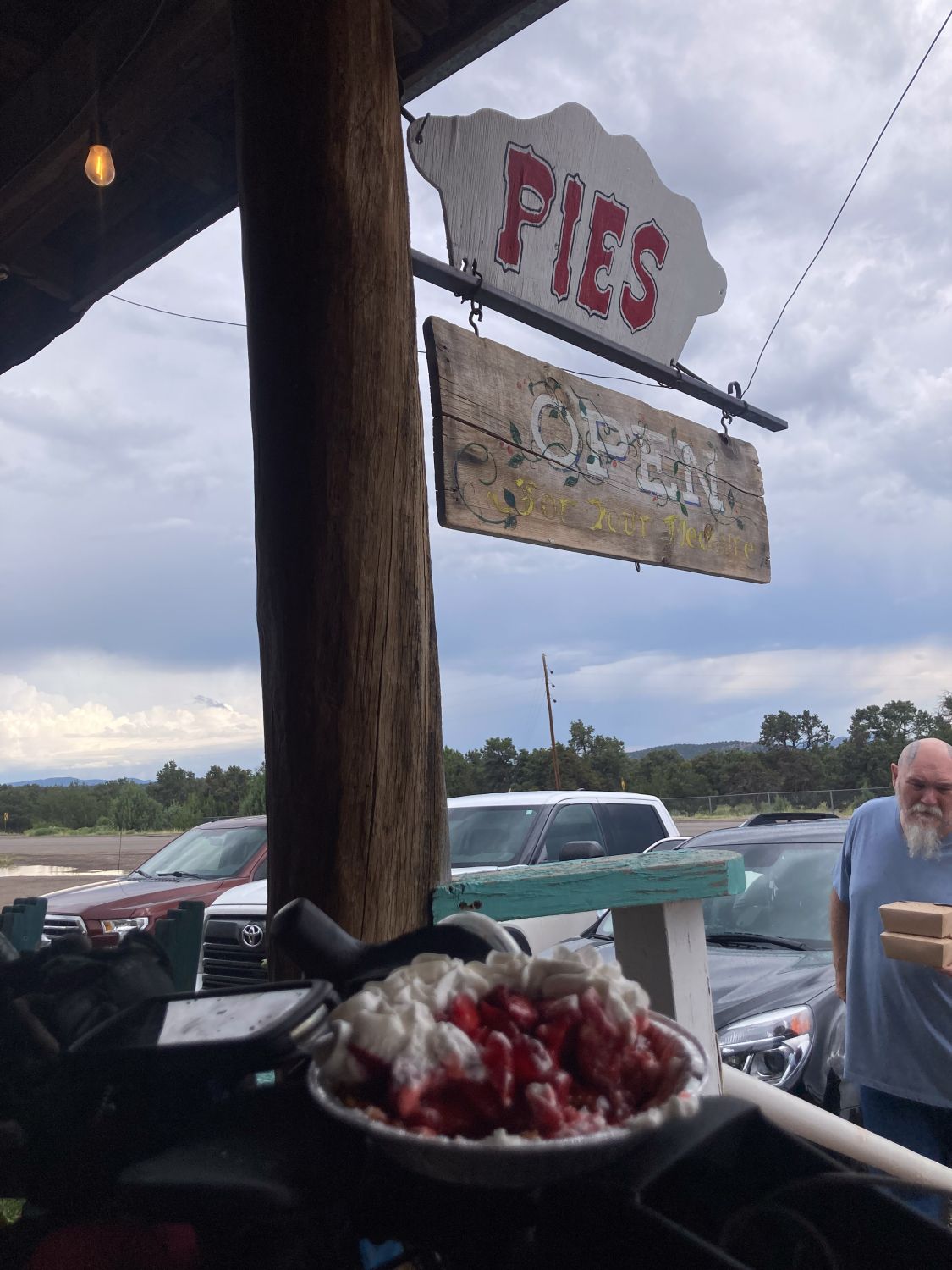
With a long day ahead I started riding around three in the morning after sleeping for a few hours. The morning was uneventful other than the fact I was heading into one of the most remote stretches of the route with almost 200 miles without any sign of civilization. The roads I was on were very poorly maintained and progress was slow. A significant portion of the roads were blown out from flash floods and it was like riding in a river bed. The weather stayed good for the first part of the day but soon enough dark storm clouds were gathering. The first storm lasted half an hour and it turned the road into a river. Luckily the ground wasn’t a surface that got super sticky when it was muddy so I was still able to make progress but my speed was easily cut in half. The one hint of civilization on this stretch of the route was the Geronimo trail guest ranch which was a sort of horse-riding retreat center and I stopped here briefly to refil my water. While I was there I connected to the wifi to look at the weather radar and I could see it was just one storm after another and if I wanted to make any progress I would have to ride through the weather. The storms hit one after the other, the worst of which was the most violent storm I had ever seen. We were riding on a ridge and the lightning would flash and instantaneously a boom of thunder that shook the ground would follow. For the most part, the road stayed rideable until one corner had a section of mud less than 40 feet long that instantly stopped my tires from turning and gummed up my drivetrain. I stopped and used the trickle of a stream to attempt to make my bike rideable, and after scooping mud off my bike I was able to ride with the sound of grinding dirt in my gears. The sun was going down but there was no way I wanted to stop and camp now, I was too wet, cold, and muddy so I made the decision I was going to push until I got to Silver City, no matter how long it took. But one important thing had slipped my mind which might have kept me from this goal, the 12-mile CDT section. This section was rough and in my sleep-deprived state of less than six hours a night for the past two and a half weeks I kept riding off the trail. The one benefit to being in this state was I couldn’t even comprehend how rough the terrain was and soon enough I had finished the 12-mile section and was onto a paved downhill to Silver City. After getting a hotel room I ate a quick dinner of whatever snacks I could scrounge up from the bottom of my bags and as soon as my head hit the pillow I was asleep.
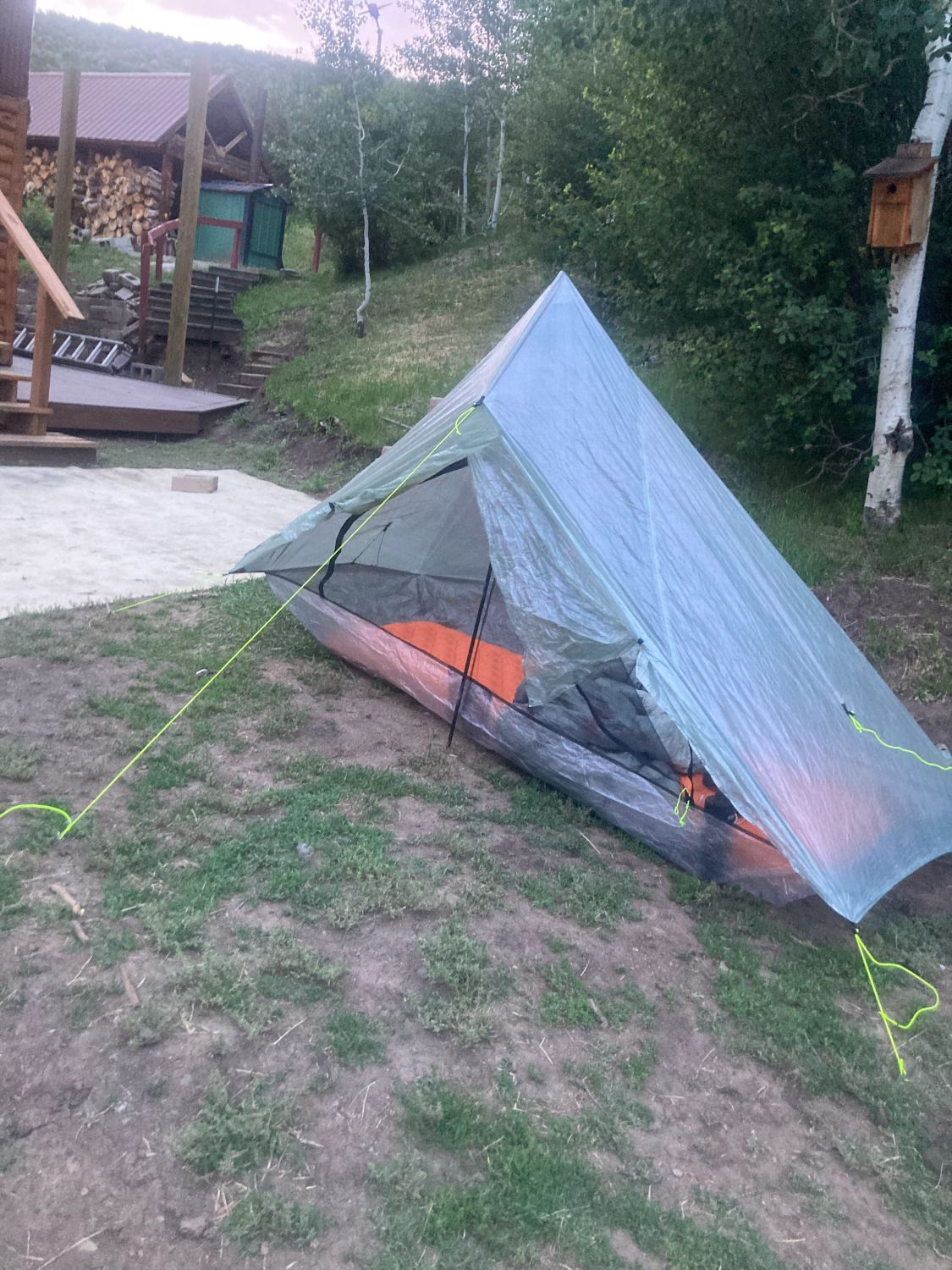
My alarm went off three hours later and I quickly got up because I knew this was my last day on the route. I went to a car wash to pressure wash the chunks of dried mud off my bike and after getting a gas station breakfast I was off to the final push. The route out of Silver City was confusing, it took us on backroads and narrow trails but eventually, I got out of the city and the only things around were sand and cactuses. By ten in the morning, it was already above 100 degrees and I was exhausted from the day before but the excitement of the finish getting closer and closer with every pedal stroke kept me going. I made a quick stop in the small town/interstate truck stop of Separ and got a few cold drinks and some ice cream which gave me an extra boost. The wind was bad but I just kept pedaling, getting more excited with every moment. Just 50 miles from the finish is another small town called Hachita and this is the last resupply point. Here I got some more cold drinks and just enough snacks to get me through this final section. Of course, it’s not an easy roll to the finish though with a 16-mile section of one of the roughest parts of the CDT right out of Hachita. This section got worse and worse the longer I rode it, first it was an unused double-track road that I was able to ride fairly easily then it started to go along the base of some mountains and had steep ups and downs that were impossible to ride and finally the trail completely disappeared with only tire tracks in the deep telling me where to go. But I was so close to the finish that none of this mattered and I just embraced my last day on this route. Soon enough I met back up with the highway and it was 30 miles of flat road to the finish. The mile markers haunted me as these last miles ticked by agonizingly slow. And of course, it wouldn’t be a day in New Mexico if there wasn’t an afternoon thunderstorm. I saw the clouds gathering behind me and this storm looked like it would be rough. As I looked back I saw a wall of rain coming toward me from behind and slowly getting closer and closer. The last thing I wanted was to get caught in a storm just miles from the finish, so I started pushing down on the pedals harder and harder using my last little bit of energy. The tailwind from the storm helped my progress significantly and soon enough I saw the lights of antelope wells. I had done it. I had set this goal and I made it happen. I had finished the Tour Divide and not only did I finish, I finished in 19 days 13 hours and 14 minutes, beating my goal by almost half a day. I had ridden my damn bike across the country and now, finally, I could rest. The finish was strange. It felt weird not having a mileage goal for the day and finally sitting down with nothing else to do. My dad helped me load up my bike into the car and I instantly downed a pint of half-melted ice cream he had brought me. As I sat there, finally resting after reaching Antelope Wells, the magnitude of the journey I had just completed started to sink in. This ride was much more than just miles and mountains; it was a culmination of dreams, grit, and the support of so many people who believed in me along the way.
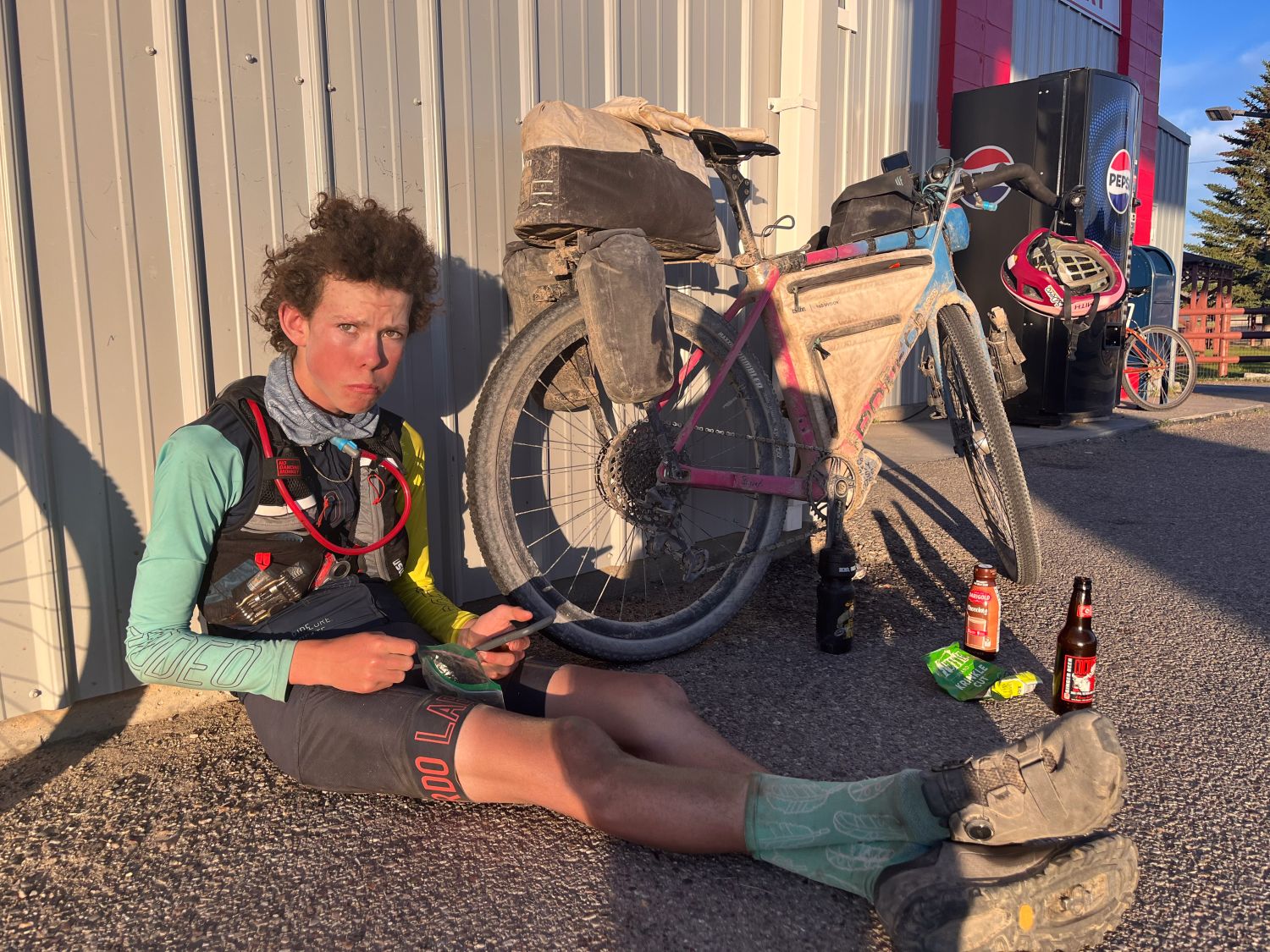
I am incredibly grateful to my parents for their unwavering support. Knowing they were there for me, whether I was pushing through thunderstorms, struggling on muddy roads, or just needing a little boost, made a world of difference. To everyone who cheered me on, checked in, or encouraged me to keep going, you helped me find strength when I needed it most, and I can’t thank you enough.
I also want to extend a huge thank you to my sponsors: Rodeo Labs, Tailfin, and the Be Good Foundation. Your support and belief in my vision were instrumental in bringing this journey to life. Your contributions didn’t just make this trip possible; they allowed me to push my limits and truly do the best I could.
This journey changed me in ways I can’t fully express. I faced challenges I never expected, but I also found beauty, resilience, and camaraderie at every turn. With each mile, I felt myself grow, as a cyclist and as a person. I’m leaving this experience behind with gratitude, and memories, ready to keep seeking new horizons. Thank you all for being a part of this journey, together, we made this dream a reality.


2 Comments
I had the honor of riding a bit of the Stagecoach 400 with Edyn when he was 13 years old. Even then you could feel the uniqualities that this young adventurer holds deep. I hope we cross paths again and… he still owes me a tube :)
So happy to read this report. I dream of doing the Divide some day and it is nice to read about what it will be like. Thanks for writing this? I would love to know what gear you put in your front handlebar bag.